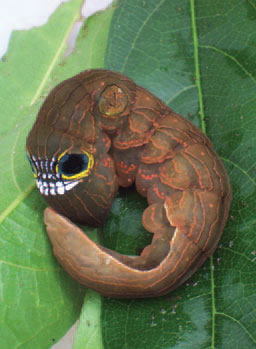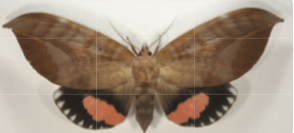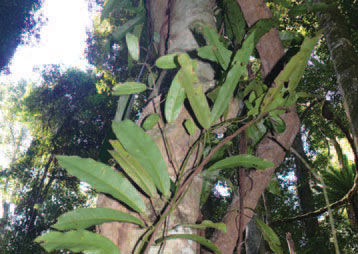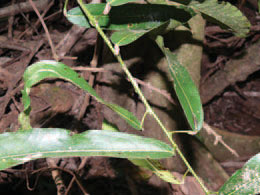Many rare and interesting plants and animals are found on Land for Wildlife properties. The photograph here shows one such animal. It is displaying large blue-black ‘eyes’ and barring rows of white ‘teeth’ in a supposed attempt to ward off predators. This animal is about 12 cm in length and is the larvae of one of Australia’s largest and most threatened moths, the Pink Underwing Moth (Phyllodes imperialis) southern subspecies.
Nick Clancy, Land for Wildlife Extension Officer, found this caterpillar on a Land for Wildlife property in the Sunshine Coast hinterland while conducting a property visit. The Pink Underwing Moth southern species was first discovered and identified by a CSIRO team in 1988 at Mary Cairncross Scenic Reserve, which, until Nick’s recent find, was the only confirmed breeding site in Queensland.
Knowing that the Pink Underwing Moth southern species larvae eat only one species of plant, Carronia (Carronia multisepalea), Nick kept an eye out for Carronia and was rewarded to find a heavily defoliated plant and a larvae.

The Pink Underwing Moth southern species is listed under Commonwealth legislation as Endangered and is the subject of a Threatened Species Network project and other activities to confirm taxonomy, locate breeding sites and raise community awareness.
Given that over 75% of rainforest and vine forests in the Sunshine Coast region are found on private land, it is obvious that landholders play a vital role in the protection of many rare species that depend on rainforests for survival.
“landholders play a vital role in the protection of many rare species that depend on rainforests for survival”
Similarly, it is vital that programs like Land for Wildlife offer sound ecological assessment and management advice.
At least 45 Land for Wildlife properties within the Sunshine Coast Regional Council region contain populations of Carronia. These properties will be revisited by Land for Wildlife officers to look for potential Pink Underwing Moth southern subspecies breeding sites.
If you own a property that supports rainforest or vine forest, you may wish to keep an eye out for any Carronia plants. This plant species is reasonably easy to identify as it has a couple of characteristics traits which are described in detail below:

Identifying Carronia
In SEQ, Carronia multisepalea is an uncommon rainforest vine found on the Blackall Range, Sunshine Coast hinterland, Mt Tamborine and the Border Ranges. Suitable habitats for Carronia include rainforests on red basalt soils (regional ecosystem 12.8.3), in vine forests on alluvial flats (regional ecosystem 12.3.1) and in rainforests on granite soils on the western slopes of the Blackall Range (regional ecosystems 12.12.1 and 12.12.16). Carronia prefers unlogged, intact rainforest remnants.
In low-light conditions, Carronia will grow as a rambling small shrub, but will rapidly grow up into the canopy as a strong climbing vine if light becomes available. Leaves are dark green and have prominent lateral veins. An important identifying feature of this plant is the petiole – the small stem that joins the leaf to the main stem or branch. The petiole is usually long and straight (up to 5 cm long) and has a distinctive swelling where it meets the leaf. The leaf distinctively grows at an angle (up to 90 degrees) to the petiole.

Carronia vines are dioecious with male and female flowers on separate plants. Their pollination vectors and fruit- dispersing agents are currently unknown.

Dr Don Sands, a retired CSIRO entomologist who has been studying this moth for over 20 years, and Nick Clancy are working together to identify potential breeding sites through analysing feeding scars on Carronia. Sites with a high likelihood of being breeding locations will be revisited during October – November when the larvae start to appear.
Pink Underwing Moth Ecology
The Pink Underwing Moth southern subspecies can grow up to 13 cms in size and has mottled brown wings that look like eucalypt leaves. A bright pink section on the underwing can be flashed if disturbed. Dr Sands believes that
the southern subspecies of the Pink Underwing Moth is threatened due to the loss and fragmentation of its highly specific rainforest habitats.
The Pink Underwing Moth southern subspecies feeds on the juice of rotting or over-ripe fruit that has not fallen to the ground (D. Sands pers. comm.). Pink Underwing Moths do not pierce fruit as do some of the related fruit-piercing moths. Adult moths live for about 30 days and probably disperse widely to suitable rainforests. Late October and December- March are the two main known flight periods.
This recent discovery of a new breeding population of a threatened species confirms that community involvement is essential to protect threatened species.
This article was compiled by Deborah Metters from information presented at the Pink Underwing Moth Revegetation Workshop held at Mary Cairncross Reserve on 12 May 2008 organised by Barung Landcare.
Ecological information about Phyllodes imperialis is from Clarke, GM & Spier-Ashcroft, F (2003) A Review of the Conservation Status of Selected Australian Non-Marine Invertebrates, Commonwealth of Australia.

Hello, I am an artist making work about the pink underwing moth. I would like to speak to a conservationist about what is useful and how to use my artwork, whether to generate interest, volunteers or gather funding for habitat and research. Best, saara
Fabulous work Saara. Great stuff. https://www.saararoppola.net/forgotten-wings-project
Probably best to chat with one of the SCC LfW Officers if you need more detail.